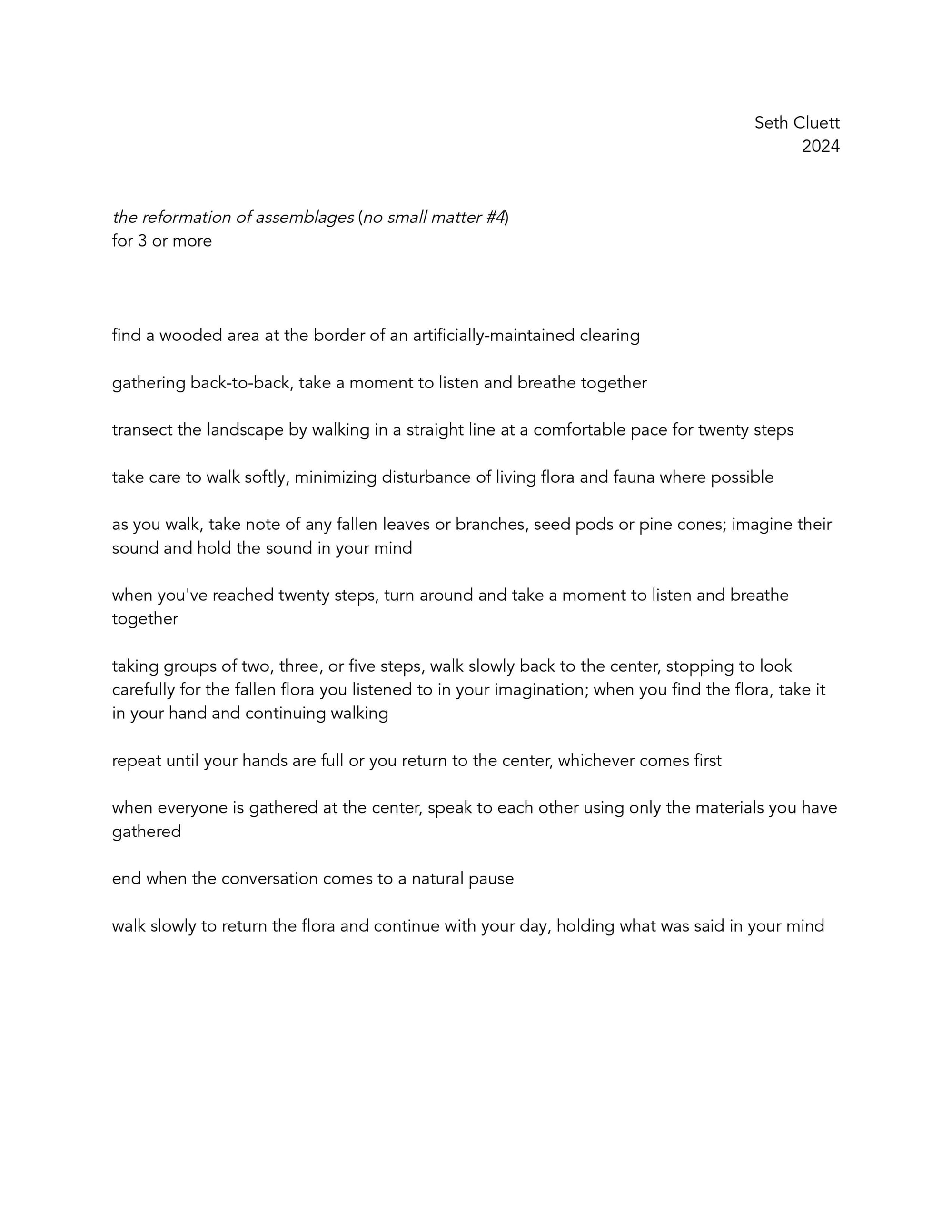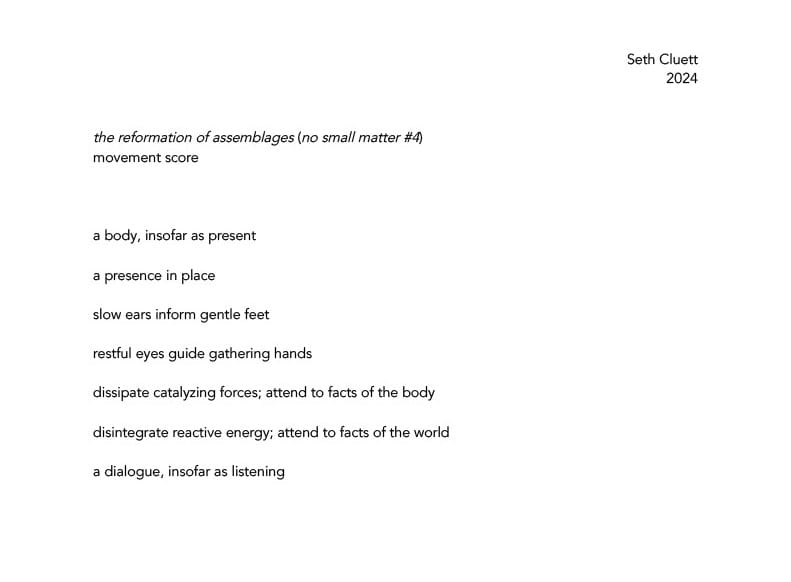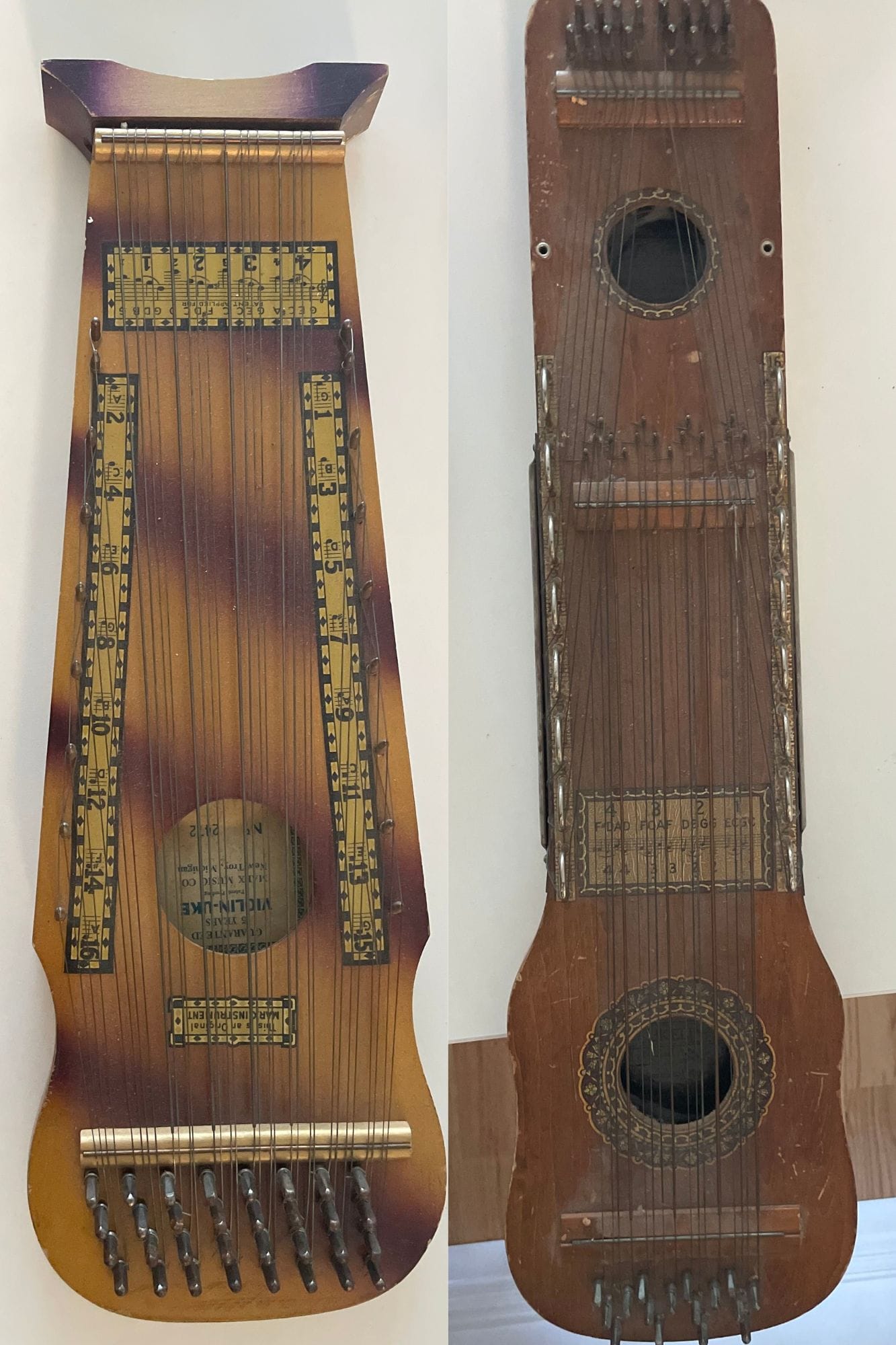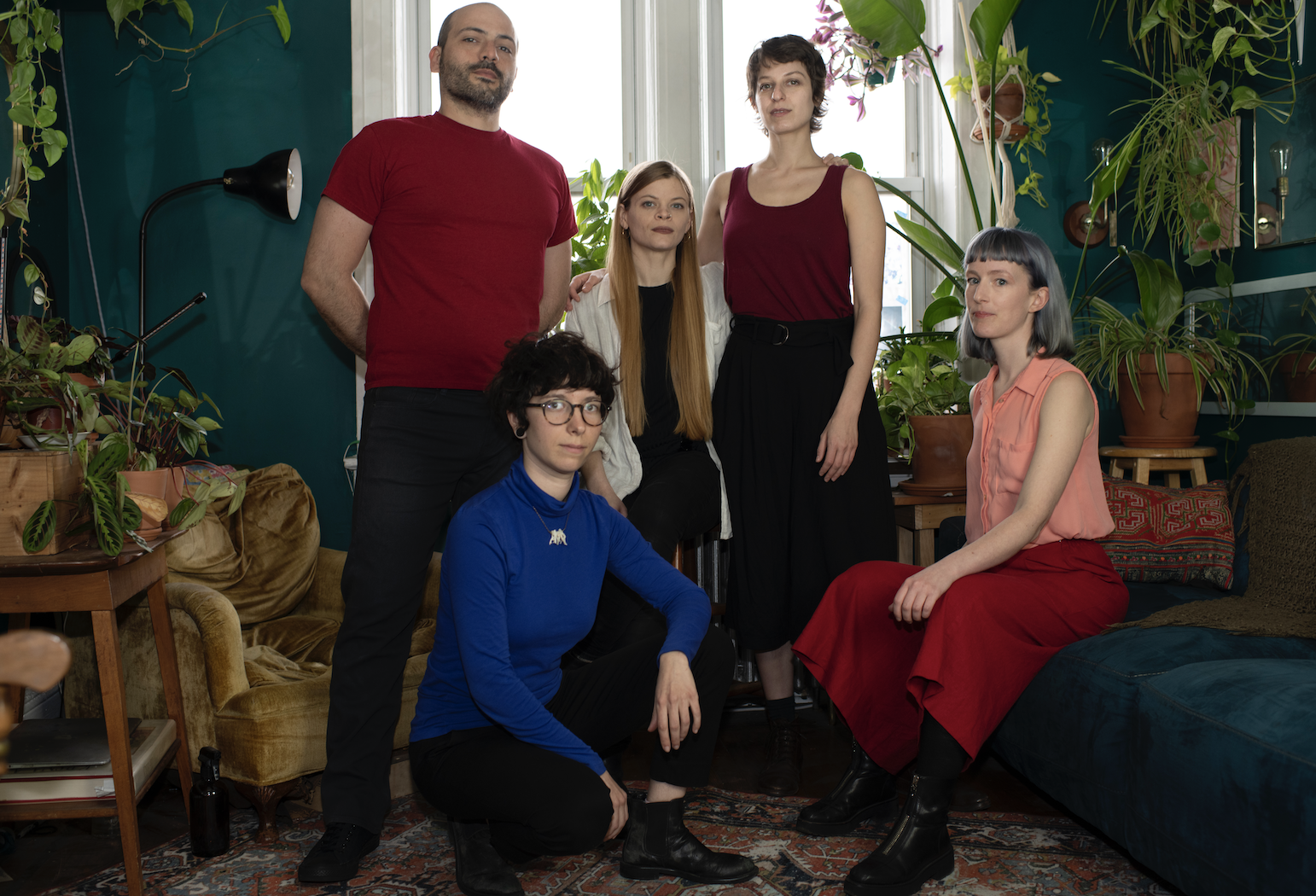Note from the Editor
I could wax poetic about NYC-based TAK Ensemble. Many have, including Which Sinfonia writers Emery Kerekes and Jennifer Gersten, as a result of their superb musicianship and curatorial prowess. But like a snowy forest floor, there’s a living musical ecosystem under that shiny glean which ordinarily goes unacknowledged. Time to shuffle the snow.
It’s a privilege to share this conversation between members of TAK Ensemble, Charlotte Mundy (voice) and Laura Cocks (flute), and NYC-based composer and professor Seth Cluett ahead of their September 22 show at Roulette Intermedium in Brooklyn. An audio recording of this conversation, with more about Seth Cluett's notation and how he developed his unique instruments, is available on the TAK Editions podcast. – Anna Heflin
Charlotte Mundy (CM): So, we are gathered to discuss your hour-long piece for TAK Ensemble, irreversible histories of disturbance, which we're going to premiere at Roulette in Brooklyn on September 22. It's a multifaceted piece, there are so many layers. Do you want to describe the piece in general, so the readers get a rough overview of what it is?
Seth Cluett (SC): Sure! The concert will have two pieces. The first is a video that we recorded in Prospect Park called the reformation of assemblages, which is thematically linked to the hour-long scored piece that you mentioned, irreversible histories of disturbance. irreversible histories of disturbance is part of a tectonic scale creative arc in my practice, where I'm limiting the number of commissions that I take and have deeper dives – longer, less pressed collaborations with people. When approaching subject matter like climate collapse in music, working quickly can lead to heavy handed results. I wanted to find a way to have the structure of ecological systems and processes inform how the ensemble interacts and guide the notation system...and that takes time.
In the score there is equal agency between me, the performers, and the audience to a certain degree in terms of assembling what the piece becomes. I have some fixed parameters regarding pitches and time and form. But then there's a great deal of constrained openness, which is not chance or aleatory. It's based on probabilities, systems, and processes that unfold over time in parallel to the notational conventions.
I also built a number of instruments that accompany some of the performer's actions, which we will get into later. There's a lot going on, even if it's going on slowly.
CM: I'm curious about the natural processes that we're imitating or emulating in the piece. Do you have specific natural processes in mind, or is it more of a generalized sort of observation of how nature functions and moves forward?
SC: The title, irreversible histories of disturbance, comes from a book by Anna Tsing called The Mushroom at the End of the World. It is a sprawling book that covers a lot of territory, but the thing I'm obsessed with is the idea that humans walking in the woods, or someone digging up their backyard, seems like a disturbance in nature but it creates the condition of possibility for life. A person’s careless or thoughtful unearthing of the ground creates an opportunity for a mushroom to grow. That in turn makes the soil more verdant and creates the possibility for more trees and flowers to take hold in the ecosystem.
This idea that ecology is a one way street where humans destroy stuff and then desperately try to reconstruct it is a fallacy. It doesn't take into regard the resiliency of natural systems if left to their own devices. There's a lot of interdependence in my composition where you're reliant on another player to move your part along. There's some symbiosis where ‘that person's doing a thing, watch them do the thing, and then be a part of them but not of them.’ There's co-dependence, such as groups of people moving in parallel, but adjacent to groups of people also moving in parallel. Like two flocks of starlings, where they're not moving in lockstep, but they’re entities moving adjacent to each other.
I developed a notation system that's adaptive to the moment – while you're playing a pitch, you’re listening for the next best rest. While you're resting, you are listening for the next best pitch from a set of choices. It is not chance, but rather an opportunity for your in-situ mind to decide what you want to do with the moment you're given – it is a parallel between nature and how we choose to engage with the environment.
Laura Cocks (LC): I'm curious if you can share how you engage with the environment, and if your process of composing and thinking about this piece for, I guess five years now, has shifted the way that you're interacting with your environment?
SC: That's a great question. I'm from very, very rural upstate New York. It was a 25 minute drive to the nearest grocery store and our driveway was a quarter mile long before the road. I grew up essentially in a forest with parents who were naming the birds, the leaves, and showing me, ‘This is an oak tree. This is a maple tree.’ We tapped maple trees when I was a kid.
Then I moved to Boston to do my undergraduate at New England Conservatory. On my first day in the dorm, I woke up to a dumpster being emptied outside of my window and thought that the world was crashing around me and that I was about to die. That tempo mismatch between the city and my body, the way that I think as a result of how and where I was raised, and the constant friction I experience in the city has informed my entire adult life.
How do I engage with urban green space as a way to reconnect with as much nature as I can get? That’s been the question on my mind for the past five years regarding this piece. I’ve come to believe that public green space is deeply problematic as we consider climate change. We use public green spaces as a sort of soporific end-of-the-work-week recreational space, or a place to do exercise and get some air. Instead of engaging nature in our daily lives, the environment has been devalued in our capitalist society and mitigated into our limited free time. This piece has made me think about how one engages with nature, and how that engagement structures the way society as a whole conceives of nature and the urgency of the climate problem. This piece explores that tension.
LC: There's that tension, and there's the tension that you also mentioned, between the tempo of habituating in Boston or here in New York, and the tempo of your body. There's tension in the tempo of a body in nature, or your body in nature growing up, and the urgency that you mentioned of the climatological situation. I wonder which of these tempos, what moments from this tension you're hoping to convey to the audience, or what listeners might be invited into from these different aspects of your experience, and the political and sociological economy around green space.
SC: I think of not-necessarily-good-for-my-career moves that I make in my creative life. I don't release a lot of music. I compose very slowly. I resist performing every day, every week, every month – the lifestyle that is expected of people who are trying to eek out a living out of experimental music. I resist the broad commodification of experience that the concert hall sometimes provides. I relish the catharsis of other people's music, I love going to concerts and hearing people's new ideas. But in terms of what I'm capable of creating and the kind of experiences I want people to have, it's important to press the pause button. For the duration of my piece, the world is in slow-mo. When I let it out, I mean it. It's not that people don't mean it when they release a lot of music. It's just that when I do three pieces in a year, I'm working on the same piece for three different people and I don’t find that satisfying.
So paying attention to one thing and letting yourself live in the patterns of it is a parallel to the engagement with nature that might help with some of the climate issues that we're dealing with. We're so distracted all the time that if we can create a scenario in which one might observe patterns, systems, the ebb and flow of time, the change of seasons – that’s huge. I'm not trying to model that behavior out of some ‘I know better than’ method. I choose to slow the processes down and give the audiences the ability to track changes over time and see processes unfold.
When I said the audience had agency to construct the piece, what I mean is that you, TAK Ensemble, have a series of visibly decipherable patterns that the audience may observe in the same way that one might sit out in the woods and check out birds. Birds are doing things on their own, and there is an agency there. When it's just – I don't want to say just but – just reading little black dots on a page from start to finish, it's like I've gotten on the bus. The bus is going to take me where the bus goes, and I'll be unsurprised by the presence of stops and starts to reach a predetermined destination. My work is a lot more like sitting still and seeing the world move around you, rather than like getting on a train and going to a place.
CM: You have asked us to spend a lot of energy listening and watching each other for cues in order to move the piece forward. And I think when the audience sees that, it will encourage them to watch and pay attention to us, to the music, and to your compositional choices in different ways. Reiterating what you just said, the audience is not made up of passengers who can shut their eyes off and listen. They're engaging and watching us figure out the piece together, which will be a really beautiful energy.
LC: Can you share with us a little bit about the video, the reformation of assemblages, and how it relates to irreversible histories of disturbance? Who are the collaborators on the video?

SC: Parallel to my notation practice, I have a long investment in text scores. I give a fairly poetic or open-languaged set of instructions for how an event might take place, and then people enact them. My most performed piece is a text score for non-musicians commissioned by the Italian curator Danilele Balit called eccentricity There is a wonderful person, Elena Bizerna, who wrote a book called Walking From Scores, and she’s recreated the worklike, 30 or 40 times. What's wonderful about it is, it's not that musicians aren’t special. It's that humans are humans, and there's some difference when non-experts are given the ability to participate in musical experiences.
The reformation of assemblages is a text score for three or more people to walk, collect material in green space, and gather to make sound with the flora. For this video, I also wrote a text score for a choreographer to advise TAK on how to approach movement, and I wrote a text score for a videographer to come up with a strategy for documenting the piece. We went to Prospect Park in Brooklyn and found a forested area of the ravine not far from the carousel We had five composers from the Columbia D.M.A. program, who volunteered to do the videotaping, and everyone performed with movement instruction from the choreographer and with video direction from the cinematographer. The brilliant choreographer, Abigail Levine, worked with Alvin Lucier. The cinematographer, Itziar Barrio, is a Basque filmmaker who does wonderful installation and sculpture work, and I've collaborated with her quite a bit.

CM: I want people to know more about the extra instruments that some of us are playing that are not part of our usual arsenal. What is the role of these pieces of bespoke technology in irreversible histories of disturbance? How do they fit into your practice in a broader sense?
SC: I've always been really uncomfortable with the word composer and have had this parallel life as a solo performer of electroacoustic live music for 20+ years. And that practice has involved the construction of devices that enable me to create in real time a kind of mimicry of field recordings.
I have a folder on my laptop of 500+ field recordings. When I start my solo electroacoustic sets, eight of those recordings show up under faders in my custom software instrument. I have no idea what they're gonna be but as I raise a fader say to myself, ‘oh, I remember when I recorded that. That's a waterfall I recorded with Pauline Oliveros in Sicily. I know what's coming, but I also know the recording is short so I don't have that much time.’ And so I'll look around the table at the devices I’ve built and I’m like, ‘well, I've got this bubble wrap, this tissue paper, and this box of rocks. How can I make a sound that would be like a duet between the foley sound and the sound from the field recording?’ And that gave me this idea.
I've kept my performance life largely separate from my composing life. But in irreversible histories of disturbance, I didn't want to be heavy-handed and have performers playing branches or something that would be really on the nose for a piece about natural process. So I created these devices that get close to the groan of a tree and imitate wind whistling or the sound of leaves.
As a result, there are these fan powered slide whistles that have a very airy, breathy sound. Slide whistles – they're comical. But when you just have a fan playing them it creates a steady drone, they're otherworldly and ethereal. The timbre is fascinating. And when you underpower it, it subtly and unpredictably whistles and flips the octave.
There's another instrument that's a three foot long pipe with a spring on the inside that has a contact mic on it, a tuning peg on one end and a bridge at the other with a single string along it. When you bow it, it comes with its own reverb, and it's unstable. A lot of the instruments are largely uncontrollable, they break fluency and upend virtuosity.

I'm also using two vintage 1930s violin ukes, which are also called marxolins or ukelins. They are somewhere between a zither and a bowed psaltery and were meant for people who were not professional musicians to learn how to play an instrument during the folk revival. Underneath the strings are numbers and letters so that people who don't read music can follow the numbers. They have a bowed component and a strummed component. The bow is like a psaltery bow, it doesn't speak evenly. For me, that's great because it's like a physical system that's resisting human interaction.
Another instrument is a table with motorized rods that spin at two different speeds. One goes at, like, between 2.5 and 3 rotations per minute (RPM), and the other one goes between 5 and 6 RPM. TAK’s percussionist, Ellery [Trafford], can attach tissue paper, leaves, or a glass plate to the rods. As they spin, they have an interaction that is regular insofar as it's seasonal. A very slow interaction with them circling out of sync, out of phase, and constantly reinventing themselves.
And the last instrument is for Charlotte, who has a set of three speakers and a transducer with a headset microphone. When she sings, the sound comes out of all three speakers and the transducer simultaneously. And then when she lifts one of them up, the sound only projects from that one. There are individual 3D prints attached to the speakers that change the timbre of the voice. It's a way for her to have a wide, otherworldly timbral palette in addition to the international phonetic alphabet vowel choices that she has in the score. The transducer is mobile – Charlotte can put it on the violin uke, the bass drum, the table, or her skull – and it will sing through those things.
Amplified voice is really interesting in the classical music world, it often references other musical works featuring the amplification. I wanted to create a wide timbral palette without mimicry and without references to, I don't know, megaphone use in police activities or things that reference other genres that have their own communities. Charlotte’s part is more about expanding the timbral palette and finding what kinds of worlds she finds herself in as a result.
CM: Totally.
LC: I love the violin uke so much. My stepmom had one when we were growing up. We were seven kids, so we were very much ‘go play outside’ kids. The only time we were allowed to play with the violin uke was when it was raining and we weren't supposed to be playing outside.
SC: Oh, that's cool.
LC: To me violin uke is, like, overcast, thunderstorms. Resisting human interaction so much that it's taken on an ethos of weather.
SC: I love this interesting time in society when there were all of these attempts to make instruments that made music more accessible. It's about our ecology as musicians. I want to live in a world where classical music is not so far from what ordinary people are capable of. There's something about that that I refuse to let go of as a composer.
CM: I also love how, one could argue that today there are plenty of softwares, apps you can put on your phone or computer that make music accessible. But having a simple piece that's just so tangible and made out of natural materials that you can find throughout North America, like, that's cool.
SC: You asked a question ahead of our conversation about how I started musicking that might be relevant here. Two things come to mind: One is that my folks built our house while I was in between 3rd and 5th grade. And when my parents' friends would come and work on the house with us – because they did everything themselves – they would play American folk music you would find in the Paxton songbook.
CM: Wow.
SC: They never get through a whole song. That was the other thing. They’d do as much of the song as they could remember. It was my dad playing guitar, my godfather playing mandolin, and another friend of my dad's playing a washtub bass. I was playing either a ukulele or a baritone ukulele depending on my age at the time, because both were small enough for my hands. That was my introduction to making music, hacking your way through half-remembered songs.
And then in my middle school, the first thing you did in 7th grade music class was learn to play the Adirondack dulcimer. It's a 3 string or 4 string dulcimer. You'd sit there with the score in front of you and just move one finger along – a whole class doing this was magical.
LC: You were mentioning the microecologies of small communities. These collisions of various ecologies, like a human ecology on top of a forest or something in the longer term implications of when those overlap. I really love that.
SC: Oh, thank you. It comes down to mutual aid. You could say someone ‘needs help,’ but that indicates a power hierarchy. The idea of mutual aid, ‘we are gonna build this thing together,’ is a recipe for getting ourselves out of the hole. It's not going to be, like, ‘if we could just help everyone.’ That denies that you're also in need of help. Which makes people feel like they're not enough if they're not an expert. The world's a lot better when there's a flat ego mentality around the need for assistance.
LC: Yeah. And also the political importance of upending virtuosity, right? There are so many folks out there, in lots of different fields, using the idea of virtuosity to justify being exclusionary and entitled.
Entitlement comes back to what you were saying at the beginning of this conversation about how we think of green space in urban environments. There is an entitlement that we take to that natural space if we're interacting with it as purely recreational and subjugated space.
SC: Yeah. The best intentions of most urban planners get things to function at about 60% of what the planner designs. And then humans are so interesting that they come up with unexpected ways of engaging with the world that no one could possibly plan for.
So much of composition and composer virtuosity has been, ‘how can I make sure the ensemble does exactly what I want them to do?’ For me, it's the opposite: How can I create a system in which the ensemble surprises me, I surprise myself, and the audience is surprised? Because when we do things together, musicking with a k, interesting things happen – things none of us could have planned for. The co-option of that by the Cagean philosophy that ‘anything that's not planned is chance’ is such an offense to humanity and the ability of the mind to create in real time. I don't think Cage meant it as an offense, but I prefer Pauline Oliveros' approach. Community before career. Right? Your individual desires as a composer are less important than the ecosystem in which we're creating. Pauline forever.
LC: Pauline forever.
Seth Cluett
Seth Cluett is a composer and artist whose work ranges from photography and drawing to video, sound installation, concert music, and critical writing. His “subtle…seductive, immersive” (Artforum) work has been characterized as “rigorously focused and full of detail” (e/i) and “dramatic, powerful, and at one with nature” (The Wire). Exploring the territory between the senses, Cluett’s works are marked by a detailed attention to perception and to the role of sound in the creation of a sense of place, the workings of memory, and the experience of time. His research interests and critical writings investigate embodied cognition, sound in virtual and augmented reality, the media history of the loudspeaker, and architectural acoustics.
Cluett holds a BM in music composition from the New England Conservatory of Music, an MFA in electronic art from Rensselaer Polytechnic Institute, and a doctorate in music composition with a graduate certificate in Media & Modernity Studies from Princeton University. His work has been presented at major institutions and festivals in Austria, Belgium, France, Germany, Hong Kong, the U.K., and other countries, along with leading venues in North America. He has participated in dance and theater works with DD Dorvillier/Human Future Dance Corp, Stephen Petronio Company, Helene Lesterin/Atlas Dance, and Jen Mesch.
He has published book chapters for MIT Press and Rowman & Littlefield, plus numerous journal articles. His work is documented on Errant Bodies Press, Line, Radical Matters, Sedimental, Crank Satori, BoxMedia, Stasisfield, and Winds Measure Recordings. The recipient of many grants and awards, Cluett is on the composition faculty in the Department of Music Columbia University where he is Director of the Computer Music Center and Assistant Director of the Sound Art MFA Program. Since 2017 he has served as Artist-in-Residence at Nokia Bell Labs.

TAK Ensemble
Regarded as “one of the most prominent ensembles in the United States practicing truly experimental music” (I Care If You Listen), TAK delivers energetic performances "that combine crystalline clarity with the disorienting turbulence of a sonic vortex” (The WIRE), and “impresses with the organicity of their sound, their dynamism and virtuosity” (New Sounds, WNYC).
Founded on the principles of curiosity, change, and caring communication, TAK is dedicated to the commissioning of new works and direct collaboration with composers and other artists and they have premiered hundreds of works to date. TAK is Laura Cocks, flute; Madison Greenstone, clarinet; Charlotte Mundy, voice; Marina Kifferstein, violin; Ellery Trafford, percussion.
The quintet has released seven albums to critical acclaim; recent records have been described as “sublime art… a masterpiece,” (AnEarful), and “one of the most distinct and eclectic releases of the year” (I Care If You Listen). Their recorded output fosters a “deep sense of connection and communication” (Bandcamp Daily), and features collaborations with Mario Diaz de Leon, Taylor Brook, Erin Gee, Brandon López, Ann Cleare, Tyshawn Sorey, Natacha Diels, Scott L. Miller, and David Bird.
Their in-house media label, TAK editions, aims to support recorded musical endeavors from across the experimental music communities, highlighting direct conversations with artists through the TAK editions Podcast. Along with their own recordings, which include their most recent album, Love, Crystal, and Stone with Ashkan Behzadi, TAK editions releases have included those of Ensemble Interactivo de La Habana, Ensemble Pamplemousse, Nina Dante + Bethany Younge, and several of TAK’s own recordings.
Deeply committed to educational collaborations, TAK has conducted residencies at institutions such as Harvard University, Stanford University, Columbia University, Oberlin Conservatory, Cornell University, Wesleyan University, New York University, The Delian Academy for New Music, and many others. The ensemble has also collaborated with the New York Philharmonic’s Very Young Composers Program and Juilliard’s Music Advancement Program. TAK served as the Long-term Visiting Ensemble in Residence at University of Pennsylvania from 2022-23.



